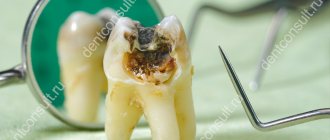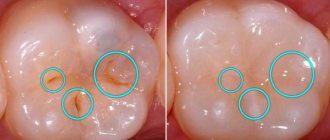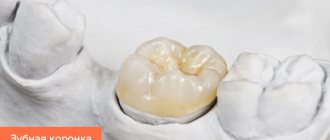Types of denture reinforcement
The type of reinforcement depends on the type of alloys used:
- In general dental practice, metal mesh is used to reinforce plastic dentures.
- The strength of acrylic bases is increased by using metal spacers, aramid threads, and fiberglass.
- The most popular reinforcing component is a mesh made of noble metals, which prevent the development of allergies and have good compatibility with other materials.
Dentists most often use meshes made of wire, perforated or cast plates:
- aramid threads,
- cellulose fiber,
- fiberglass,
- polyethylene,
- carbon mesh,
- quartz fibers,
- cast alloy gaskets,
- mesh made of gold and silver alloys.
Indications and contraindications
It is worth noting that the reinforcement does not have a negative effect on the configuration of the prosthesis, guaranteeing comfortable wearing of the reinforced structure. The technology involves placing inserts inside the base, excluding contact with the mucosal surface.
Common factors that determine the need to strengthen dentures include:
- Features of the anatomical structure of the dentofacial apparatus, manifested in a narrowing of the oral fissure;
- There is a possibility of structural damage associated with natural wear and tear;
- The specific configuration of the bed, which determines the need to strengthen it;
- Excessive mobility of one or more elements of the dentition;
- Weakening of the fixation density, leading to the formation of frayed areas of the palate.
Possible limitations, as a rule, are associated with personal indications of the clinical picture, and are identified in the process of undergoing comprehensive diagnostics.
Manufacturing and general requirements
From a technical point of view, reinforcement is a complex process that requires the involvement of an experienced dental technician in the procedure. The algorithm provides a number of sequential actions:
- Assessing the condition of the jaw apparatus and determining the load on supporting elements;
- Making a mesh frame using a plaster prototype;
- Adjustment and placement of limiting inserts;
- Coating the base with a polymer layer to fix the base;
- Final coating of the mesh, grinding and polishing of the prosthesis.
Integration of the amplifier into the base is caused by insufficient influence in other areas. It is recommended to strengthen deep areas that are characterized by a relief coating. The duration of work varies within one to two weeks from the date of application.
A mandatory condition observed as part of the reinforcement protocol is the exclusion of materials that can cause an allergic reaction. The acrylic composition used as a fixing layer, as well as the metal elements that make up the mesh, can cause negative side effects that not only limit the use of the prosthesis, but also threaten the patient’s health.
Advantages and disadvantages
Positive factors that determine the feasibility of reinforcing dental prostheses include:
- Increased strength and reliability;
- Maintaining wearing comfort;
- Ease of hygienic care;
- Increased service life;
- Aesthetics and functionality.
Strengthened models allow you to increase the load on the dentition without fear or negative consequences, which is important for patients in the older age group.
Among the disadvantages characteristic of the technology, there is an increase in the weight of structures reinforced with metal frame inserts, which results in a repeated passage of the adaptation period.
General requirements for reinforcement of removable dentures
When choosing material for reinforcement, the following factors must be taken into account:
- Biocompatibility (no allergy to it).
- Resistance to mechanical, chemical and bacterial influences.
- Durability, long service life.
- In general, the finished prosthetic structure must meet these requirements.
- Ideal fit to the gums.
- Accurately convey occlusion.
- Have a sufficient base thickness (about 2 mm).
- Do not have weakened zones in the polymer material, which can arise when the polymerization regime is violated.
- Acrylic teeth must be properly cured.
Purpose of the method
The use of the technique is appropriate for plastic removable structures, since it is the thin layer of the base that is most often subject to destruction.
Additionally, the plastic base is prone to wear and thinning. To increase strength, the developers decided to use special meshes made of metal or fiberglass.
After introducing a metal thread into the base of the prosthesis, it becomes more durable and resistant to mechanical damage.
This procedure cannot be called mandatory during the manufacturing process, but often it is the reinforcement that helps prevent the base from crumbling in the event of damage.
The reinforced base perfectly holds the entire area of the structure, so its use becomes more convenient.
Splinting teeth with clasp dentures –
If you look closely at Fig. 16-17, you will see that in the area of the inner surface of the lower teeth the prosthesis has an additional thin arch that tightly covers each tooth. This allows the teeth to stand firmly in place and transfer the chewing load from themselves to such a metal arch, without experiencing overload.
The big advantage of such dentures is that they allow you not only to splint mobile teeth, but also to simultaneously restore missing teeth. Read more about this type of prosthesis here .
Why do dentures break?
If you use structures carefully, following all operating rules, then the likelihood of them breaking is extremely low. If the product does break, then the following factors contribute to this:
- Poor quality materials from which the base or fittings are made
- Increased load on the prosthesis
- Violation of the manufacturing technology of an orthopedic structure
Let's look at these factors in more detail.
Low quality of the prosthesis is determined by the following characteristics:
- The material from which the plate is made has insufficient tensile, impact, and bending strength
- The polymer ages over time
- The strength of the base decreases with water absorption during polymerization
Despite the fact that reinforcement significantly increases the strength of the prosthesis, such prostheses break for a number of reasons
Loads placed on the prosthesis cause failure in the following cases:
- The patient puts heavy and frequent loads on the structure
- Increased loads arise due to the individual characteristics of the patient’s jaw structure
- Complex jaw prosthetics were performed (the structure was installed after surgery to eliminate any pathology of the teeth or jaw)
Violations of prosthesis manufacturing technology are as follows:
- Foreign bodies get into the polymer mass
- Wax particles remain on the teeth, disrupting the shape of the structure.
- Base thickness varies from place to place
- Artificial teeth are soldered into the base incorrectly
- The fittings are installed incorrectly
- The central relationship of the jaws is incorrectly determined
- Violation of polymerization technology, for example, too rapid cooling
- Uncorrected bony protrusions
- Violation of occlusion (contact of the upper and lower units)
Advantages and disadvantages
When a client of a dental office decides to install a reinforced orthopedic structure, his attending physician must describe in detail all the pros and cons of such a procedure.
The absolute advantages are:
- high strength;
- durability;
- comfort;
- reliability;
- ease of cleaning;
- the ability to increase the mechanical load on the teeth;
- aesthetics.
If we talk about the disadvantages of such structures, they are as follows:
- increase in weight (when using metal mesh);
- long addiction;
- temporary change in diction;
- high thermal conductivity;
- high price for reinforcement with precious metals.
It is important that the prosthesis does not cause discomfort after installation.
Features of the classification of toothless jaws according to Oxman and other authors.
In this article we will discuss the cost of relining a removable denture.
Here https://www.vash-dentist.ru/protezirovanie/semnyie-p/zubnyie-na-prisoskah.html reviews about dentures with suction cups are offered.
In what cases is tooth reinforcement performed?
Doctors perform reinforcement of pulpless teeth that have been severely destroyed as a result of deep caries, pulpitis, periodontitis or due to trauma. The roots and coronal area can be subjected to this manipulation. Next, a composite material is built up or artificial crowns are installed, which accurately recreate the anatomical shape, color and functionality of a natural tooth.
On a note! The procedure can be performed in cases where the patient is diagnosed with inflammation of the periodontal tissues, leading to loosening of the roots. Teeth that are loose due to periodontitis or periodontal disease are strengthened with fiberglass threads, which keep them from falling out and correctly distribute the chewing load, but here it is more correct to talk not about reinforcement, but about splinting.
If one tooth is missing, the specialist can also offer you a reinforcement procedure with special materials in order to quickly restore the defect and restore the integrity of your smile. For example, with direct restorations, doctors build up the crown with a composite on fiberglass threads fixed between two supporting adjacent teeth. This will allow the patient to solve the problem of partial adentia in one visit to the clinic.
General requirements
Before deciding to install a reinforced prosthesis, you need to find out if you are allergic to metal or acrylic. It is an allergic reaction to some component of the metal that can worsen the condition.
It is important to consider the following points before installation:
- Allergy to acrylic compounds or precious metals.
- Increased tooth wear.
- Severely loose teeth.
- Low height of supporting teeth.
- Malocclusion.
If the patient has such characteristics of the oral cavity, then strengthening the structure may be prohibited.
It is important that the material meets the following qualities:
- possibility of high-quality processing;
- biocompatibility;
- high strength;
- hypoallergenic;
- aesthetics;
- minimal shrinkage.
How long do acrylic dentures last?
Dentures without reinforcement last approximately 3 – 5 years. If you properly care for it and handle it with care, its service life increases to 7–8 years.
If used incorrectly and poorly maintained, the product may not last even the required 3 years.
However, the service life of the product depends not only on its quality, but also on the rate at which the jaw bone decreases. Even if the structure does not break, it has to be replaced due to the fact that the bone tissue decreases in volume.
Acrylic plates on which artificial teeth are attached can last a very long time (8 – 10 years) under favorable conditions.








